Employee wellbeing. Work with own wellbeing level
Find out if you have any burnout signs
When working with your own well-being in the company, your main task is to prevent burnout. Or, if the burnout did happen, find out the causes of your condition and outline a plan to remedy the situation. Ask yourself the following questions to see if you have symptoms of burnout:
Have you become cynical or unsympathetic towards your job?
Do you force yourself to go to work?
Have you become short-tempered with colleagues or clients?
Do you lack energy to be as productive as you used to be?
Is it hard for you to concentrate?
Have you started consuming more calories, drinking alcohol?
Have your sleeping schedule changed? Have it become harder for you to fall asleep and wake up?
Have you started suffering from headaches, stomach/intestinal or other health problems?
Have you become less happy with you achievements at work?
Have you ceased talking about your job to your friends and family with joy?
If you answered "Yes" to at least one of the questions, you should find out the causes of this condition and try to solve this problem.
Analyze
Analyze the level of your workload
Researches show that high workload, long overtime hours and unstable work schedule are badly affecting a person's well-being and stress levels and can result into professional burnout.
Analyze the overall communication load
To do this, go to the "Working Hours and Communication Load" section in the Yva.ai system, and look at the "Digital activity" diagram. It reflects the dynamics of your activity in corporate communication channels.
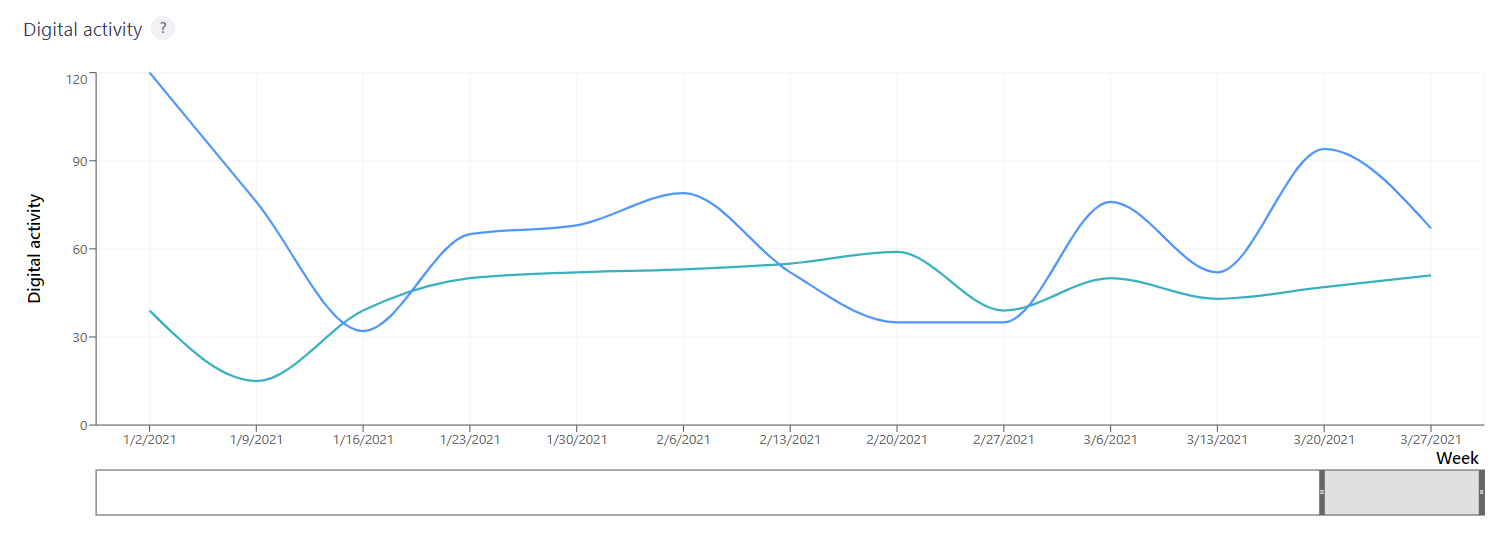
Analyze in what periods the dynamics of your communication declines, and in what it increases? At what stage are you now? Compare your activity with activity of the company. Is it above or below average? Does this difference matches the essence of your work?
If you see a sharp increase or decrease in activity on the diagram, think about what this could be connected with? For example, an increase in workload may coincide with the start of a difficult period. And a decline may mean the end of this period. Such fluctuations on the diagram can be small and indicate a cyclical nature of your workflow. If the burst of activity in the diagram was extremely big or long, then the decrease in activity may indicate that the person has an accumulated fatigue and begins to feel frustration. If your Activity Index is far above the norm for a long time, ask yourself, if you feel stress or exhaustion? If it is the case, then you need to understand what exactly it is associated with.
Evaluate the width of your workday
The first thing you need to pay attention to is the length of your workday. Look at "Active Workday Width" diagram. It reflects the average time of starting and finishing communication for each week.
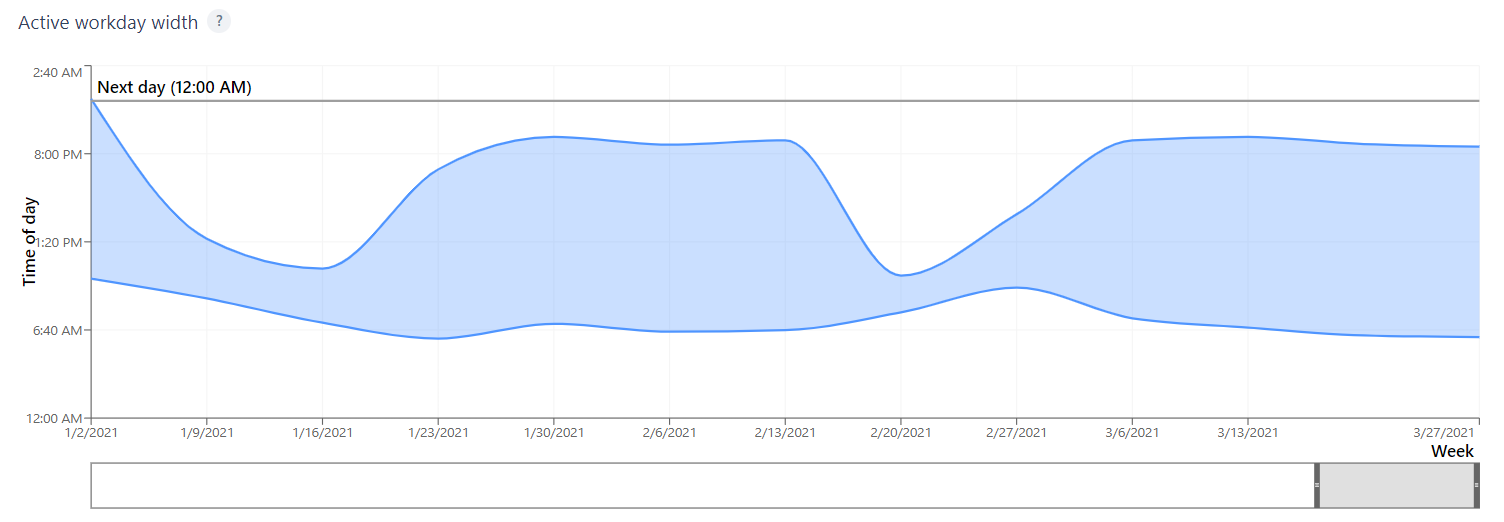
Observe the dynamics of the diagram. How does your workday change from week to week? Does the diagram show long overtime periods? Is your work schedule stable? When analyzing, keep in mind that the diagram in the system does not include tasks that are not related to your digital communications. Such as complex analytical tasks or meetings with colleagues. Moreover, if some part of your communication takes place in personal messengers not connected to Yva, for example, Telegram or WhatsApp, then this activity will not be taken into account in the diagram.
If you realize that your work schedule is intense or unstable, answer yourself: does this affect your emotional state? If yes, think about whether you have a possibility to adjust the workload. Maybe you should talk to your manager and discuss delegating some tasks or functions to some of your colleagues. Or look for other ways to optimize your workload together.
Pay attention to the volume of incoming emails and tasks
If you do not find significant deviations affecting workday width, pay attention to the volume of incoming and outgoing communications.
Look at the diagrams that reflect intensity of incoming messages you receive from colleagues inside the company and from external domains or email addresses.
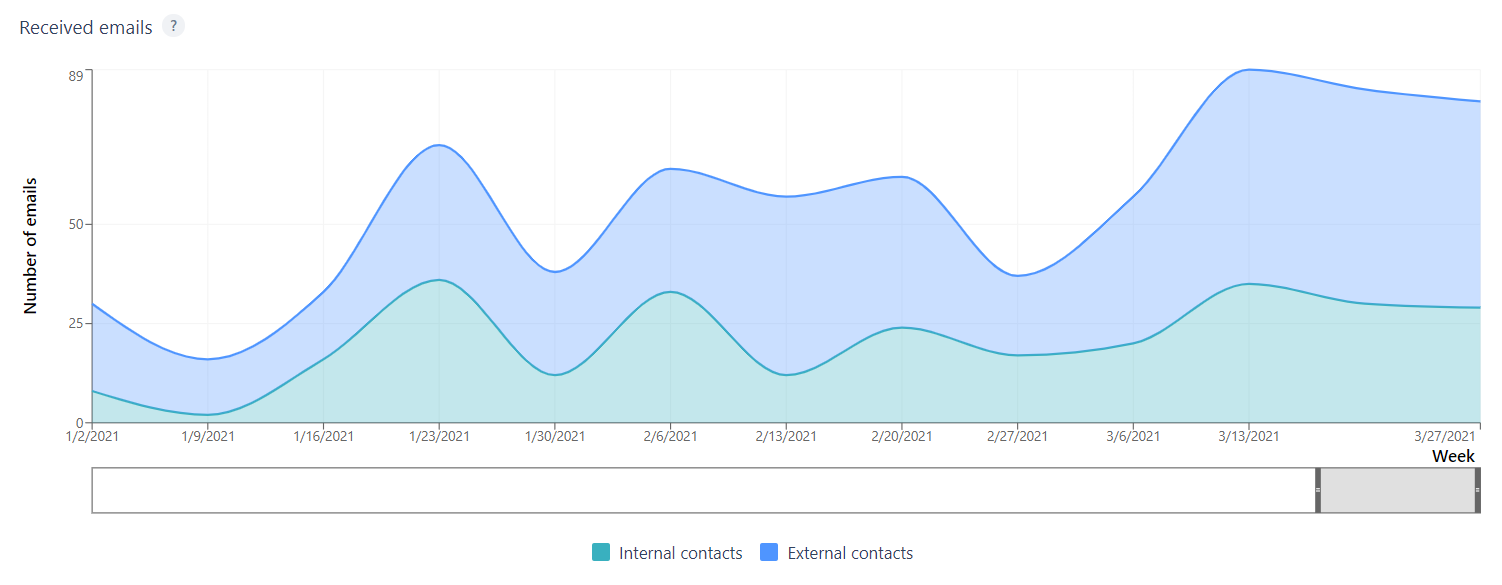
Are the emails that you receive mostly internal of external? How does your communication load change from week to week? Do you notice any peculiarities, patterns?
If the number of emails is excessive for you, look at the emails as such. Perhaps some of them do not imply your active participation or response. Analyze if it is possible for you to opt out of receiving such emails? For example, you can ask your colleagues to remove your address from the mailing lists irrelevant to your work.
You might analyze also how many emails refer to the tasks assigned to you. The diagram "Incoming emails with tasks" will help you to do it.
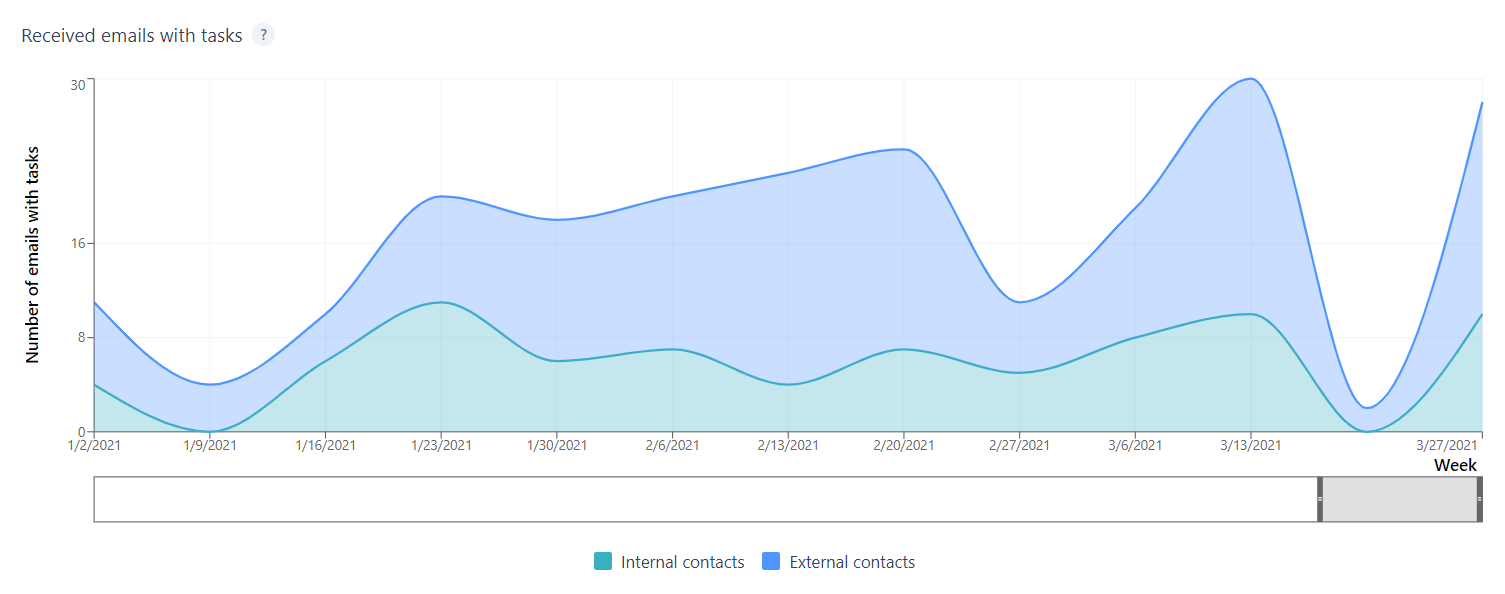
How does the amount of tasks received change from one week to another? What is the share of tasks among all the emails? Are there periods when you receive too many tasks?
If certain periods are overloaded for you, monitor your perception: does this situation affect your well-being, motivation? Is there anything you can do to adjust the load? For example, discuss with your manager possibility of even distribution of tasks or possibility of additional support during "peak" periods.
Pay attention to the volume of emails and tasks you send
How many emails do you send weekly internally and externally?
In order to analyze this parameter, open the "Outgoing emails" diagrams on the "Internal Communication" and "External Communication" tabs.
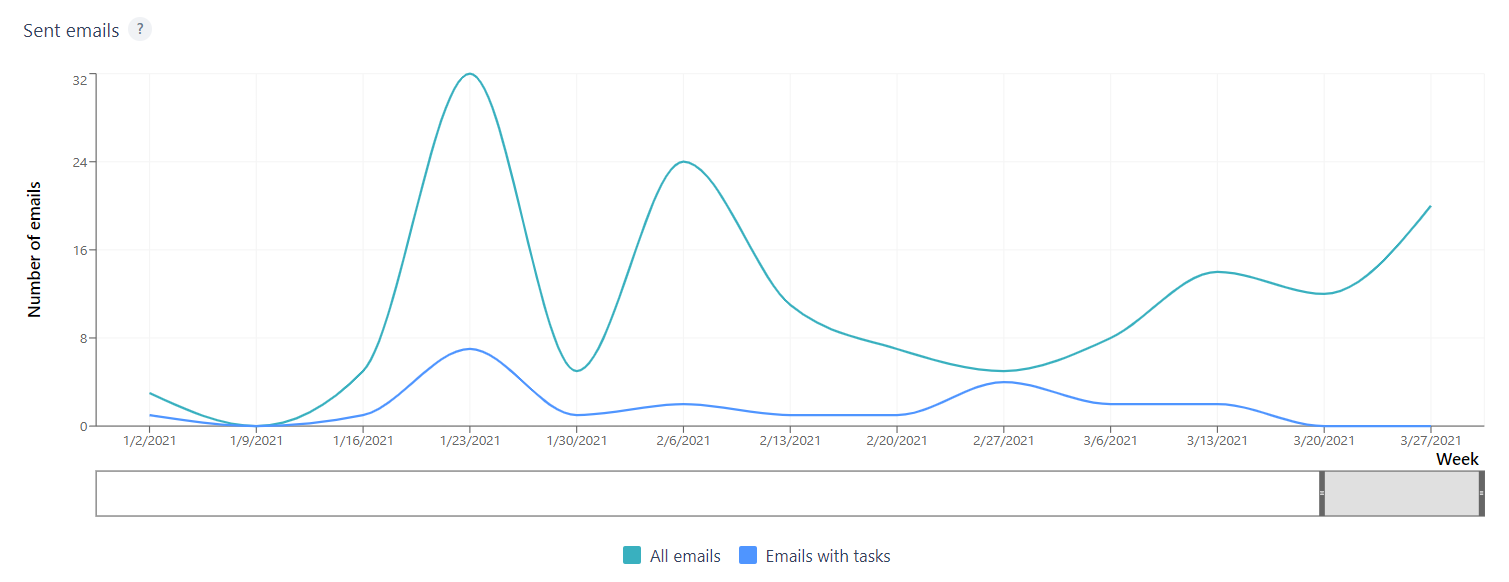
Find out how many emails do you send internally? And externally? How many tasks do you set? Look at the dynamics of your activity. Are there periods with excessive number of emails sent or tasks assigned? Or maybe you see instability periods in your work? Do you feel overloaded due to it?
Do you think that your patterns of communicating with colleagues and setting goals are optimal for your role? Are you spending too much time on written communication? Or maybe the number of agreements and decisions reflected in the correspondence is too small? What about reducing your workload?
Analyze your emotional tension
Review how your work activity affects your emotional condition. To do this, analyze the following:
Incoming Emails Tonality diagram in "Working Hours and Communication Load" section.
Incoming Emails Tonality diagrams in "Internal Communication" and "External Communication" sections.
The amount of negativity and conflicts in emails sent or received by you is shown in the diagrams. Here you can see your emotional state during different periods of work.
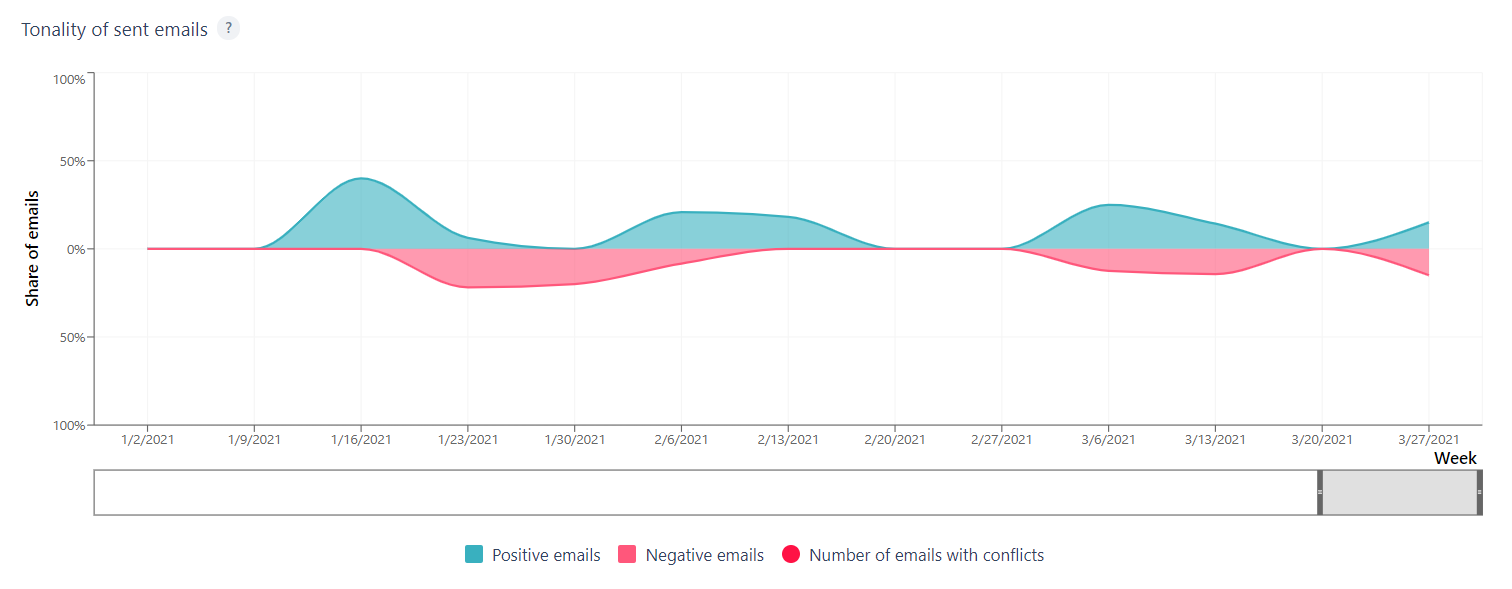

Pay special attention to the periods with a lot of negativity or conflicts. Analyze:
What events took place during the period marked as stressful in the diagram?
Did you have any work conflicts? Are they already over or continue? If they are over, are you satisfied with the outcome? If they continue, is there anything you can do to fix the situation? Try to focus your efforts on ending long-running conflict. Engage someone you trust, for example, an HR specialist, your manager or a close colleague.
If you see a lot of negativeness in outgoing messages, consider if this could be related to events from your personal life. Did you manage to resolve the consequences of these events? Do you feel like you still care about it? What can you do to help yourself? Can the company help you get through this difficult period? Maybe you should seek help from your trusted colleagues.
Be attentive to your emotional state. Excessive emotional tension can have a significant impact on your burnout level.
Take a closer look at your social capital
Analyze in what type of social capital you are a leader, and what skills your colleagues note in you. It is possible that profile of your current position does not quite match your psychological profile. For example, you are good at getting along with people, but your current position does not require this skill.
Analyze:
What type of social capital stands out in your personality? In what types did you enter the top 10? And the top 30?
What is your leadership profile according to assessment performed by your colleagues? Do you agree with it?
What strengths are noted in the profile? Do you agree with it?
What weaknesses are noted in the profile? Do you agree with the opinion of your colleagues about you?
Do you like your current role? Do you feel comfortable enough when completing your tasks?
Perhaps certain part of the work you do is contrary to your nature. Performing tasks that are contrary to human nature demands enormous efforts from the person. As a result, one feels himself not successful enough in his work.
If you've found great discrepancy between your profile and your job responsibilities, ponder over how to remove or minimize the duties in which you are less successful. Is it possible to change the approach to performance of these functions?
You might want to discuss this situation with your manager. He can adjust your tasks. If the controversies are significant, you should discuss them with an HR specialist. You may need to change department or position.
Outline a plan and take action
Once you've found the causes of your emotional state, take action:
record the causes in any convenient way,
think about what you can do to fix the situation,
write down a clear plan of action, take action!